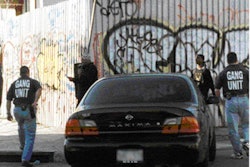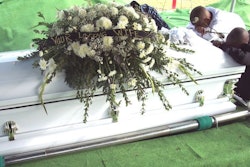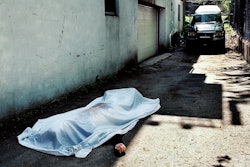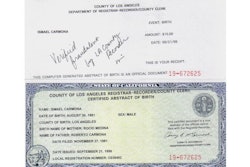Perhaps you remember the 1965-67 television sitcom about a calvary troop that just could not do anything right. One of the largest and most violent gangs in California took its name from this sitcom.
The gang, which was formed in the Santa Ana area by primarily Hispanic members, was known as Fx Troop or F-Troop, and claims that the original roots of the street gang stretch back from the 1940s, but it adopted its new name in the mid-1960s.
In August of 1992, the local Mexican Mafia leader and local heroin hype, Peter "Sana" Ojeda, called a meeting in El Salvador Park (east of the Santa Ana River at Civic Center Drive and Raitt Street) of representatives of more than 50 rival Hispanic gangs. Leading the meeting of several hundred gang members was Mexican Mafia members Peter "Sana" Ojeda, Mike "Musclehead" Salinas, Raymond "Champ" Mendez, Ambrose "Sporty" Gil, and La Eme associate Arturo "Art" Romo.
Art Romo was an F-Troop gang member and supporter of fellow drug dealer "Sana" Ojeda. Art Romo had drug contacts in other gangs, such as Logan, Delhi and the Alley Boys. He also had contacts with Mexican and Columbian drug cartels. Art Romo ran a T-shirt screening operation called A&G Exquisite Designs (or "Maldito") with his fellow F-Troop homeboy Gomercindo "Gomer" Rios.
After the infamous El Salvador Park meeting, Art Romo organized the "United Gang Council" to support La Eme and "Sana" Ojeda's gang edicts. This ordered "peace treaty" was actually the enforcement of the Mexican Mafia rules of engagement and taxation. These edicts did not stop gang murders; they only prohibited the drive-by shooting tactic. But the gullible politicians and the media ate it up like piranhas on a pork chop. They treated the Mexican Mafia's gang truce leaders as if they were neighborhood heroes.
A few months after the meeting in El Salvador Park, Art Romo was arrested for laundering $59,900 for a Columbian drug cartel in a cocaine sting. U.S. District Judge Gary L. Taylor was impressed by the 125 letters of support for Romo; he felt that the letters expressed "true, heart-felt praise" for Romo's "really wonderful assistance to the community." However, the judge imposed the maximum sentence allowable in federal prison, but within a couple of years Romo was back in the F-Troop barrio.
In 1992, the DEA arrested Ojeda on federal weapons charges in Operation Green Ice. Following Ojeda's arrest, DEA Agent Santos Miranda received death threats from the Mexican Mafia. Ojeda was eventually convicted and sentenced to federal prison. In 1995, the other Mexican Mafia members who were also present at the El Salvador Park meeting were indicted and convicted in a RICO conspiracy.
Art Romo continued doing the Mexican Mafia's business with his front organization, called the United Gang Council. However, Santa Ana's Community Policing Team, Sgt. Dan Beaumarchais and Det. John Hibbison were not fooled by the good-guy media version of Art Romo. The DEA and Mexican Army Maj. Felipe Perez-Cruz in Tijuana's Office of the General Prosecutor (Procuraduria General de la Republica, PGR) were also looking for Art Romo because of his connections to drug cartels in Tijuana and Columbia.[PAGEBREAK]
In March of 1998, the DEA and Orange County task force requested the assistance of the Los Angeles County Sheriff's Department to take down an F-Troop drug operation. LASD's Major Narco and, later, Prison Gang Unit assisted in the take down of this operation, seizing over 260 kilos of cocaine. F-Troop members Fernando Melendrez, David Ramirez and Art Romo were arrested and charged with drug-trafficking conspiracy.
This wholesale $5 million cocaine seizure brought out the Mexican Mafia's legal "dream team." From the high-powered Osajima Law Office, Glenn K. Osajima himself took the lead. His second was defense attorney Shirley MacDonald, whose ex-con husband Albert "Babo" Juarez was a validated Mexican Mafia associate and a suspected made member. In the past Shirley MacDonald Juarez represented Mexican Mafia Godfather Joe "Pegleg" Morgan in lawsuits against actor Edward James Olmos involving the movie, "American Me" (1992).
Attorney Shirley MacDonald and her husband were listed as assistant director and director of "The Cause: Cultural Awareness Uniting in Special Efforts." This was, in my opinion, another front organization of La Eme. Other members of the board of directors included La Eme attorney Daniel Guerrero, and Paul A. Sharp — the program director of the American Recovery Center (American Hospital) in Pomona, Calif. Sharp's son, a La Eme associate, was convicted for the "taxation" and home invasion robbery of a drug house in Whittier in 1994.
Like Art Romo's United Gang Council, the Mexican Mafia infiltrated community organizations such as "No Guns," "The Cause" and various drug rehab programs all are used to establish an appearance of legitimacy. They generated letters of support, "counseling," and drug program certification for individuals favored by the Mexican Mafia prison gang. Romo's "125 letters of community support" were meant to flood the courts, probation and parole with false positive reports that could influence the justice system, as well as genuine community and civic organizations.
I testified as the Mexican Mafia gang expert during Romo's trial. As the trial progressed, I noticed a diminishing effort to defend Romo's interests. As the case closed, I received information from an informant that Romo's co-defendant Melendrez and Gomez had been given orders to hit their own homeboy. Romo was convicted and placed in protective custody but remained at the Orange County jail for several years, appealing his case and delaying sentencing.
In July of 2000, Mexican Mafia veteran Roland Berry was arrested for meth trafficking in San Bernardino and Orange County. He had travelled to Southern California from his home in Hawaii to secure sources for his "ice" dealing.
Hearing that Berry was to be moved from San Bernardino to the Orange County jail, Romo offered to relinquish control of a portion of the Orange County jail to Berry. Roland Berry replied in his typical bravado fashion, "I've been a brother since the early '70s, was part of the Famosa (Famous) in Tracy (the Mexican Mafia was founded at Deuel Vocational Institution in Tracy, Calif.). Now are you a brother? Yes or no?" He then signed the kite (written message), Roland-EME.
This Berry kite was disrespectful and questioned any control Romo might have thought he had. Romo's association with high powered La Eme members, his loyal service as a liaison to the drug cartels, his close association to Mexican Mafia lawyers, and his usefulness as a front man, meant nothing when challenged by a real made member.
This began this pawn's fall from grace. Art Romo was just another example of an F-Troop member who just couldn't get anything right.
















